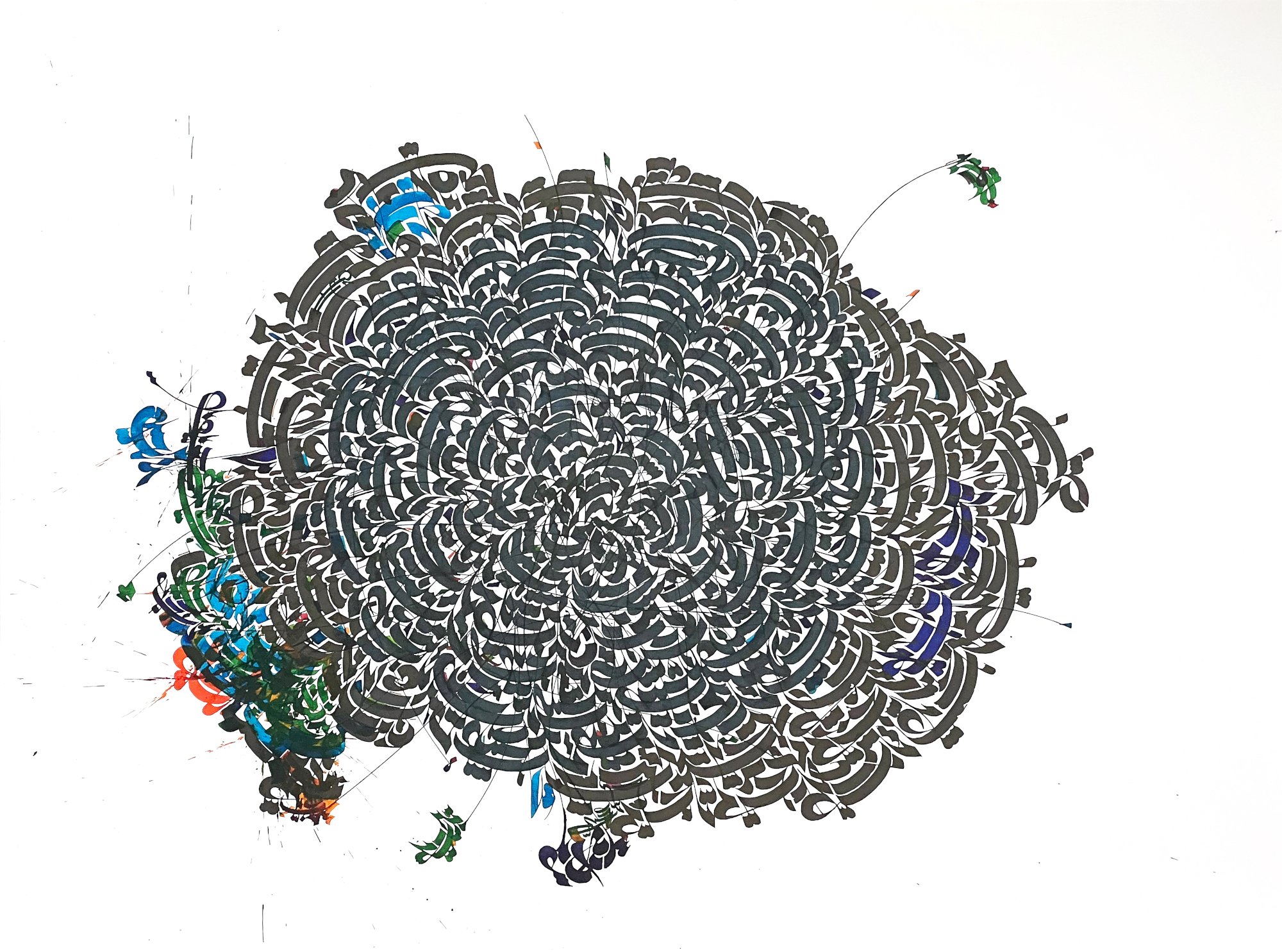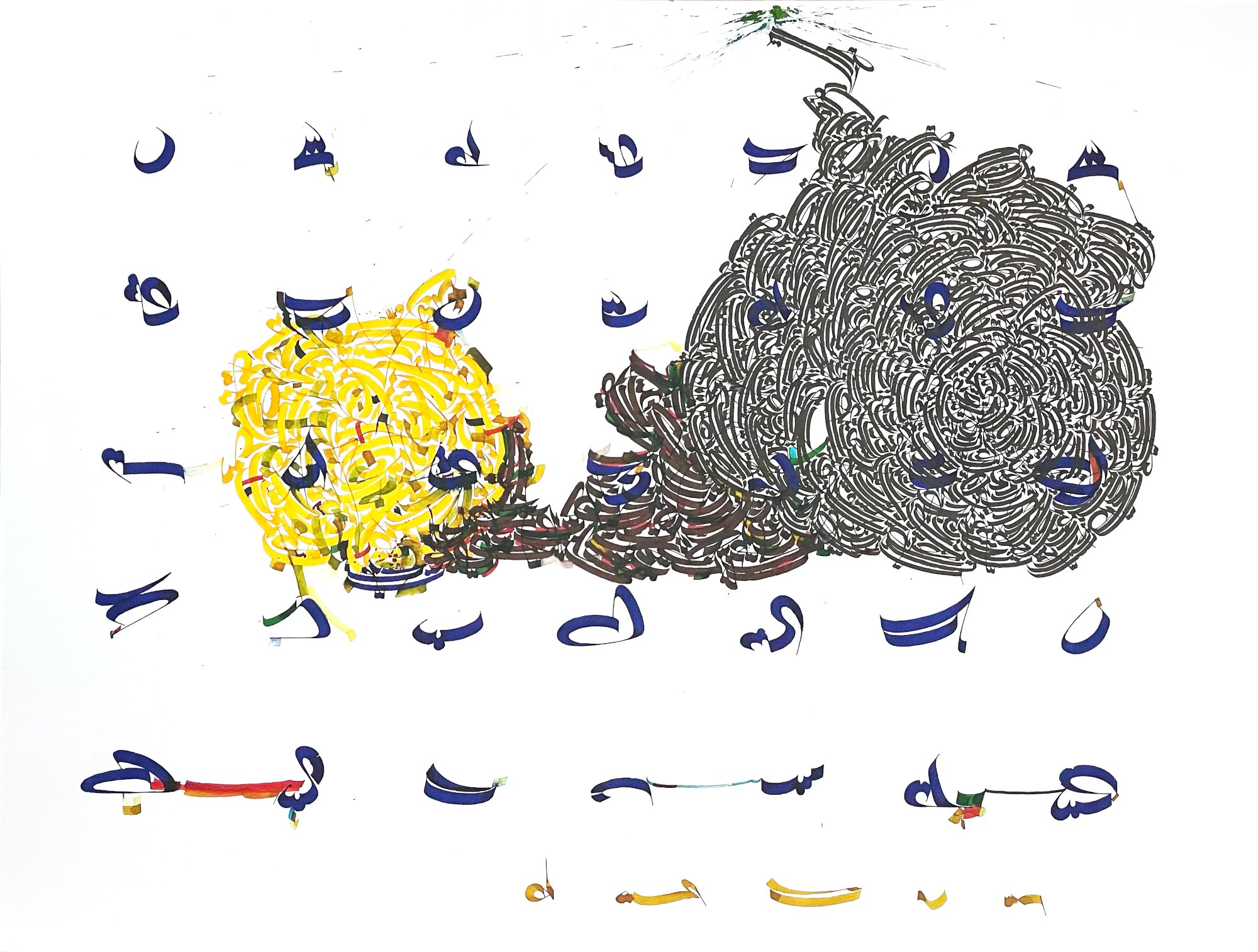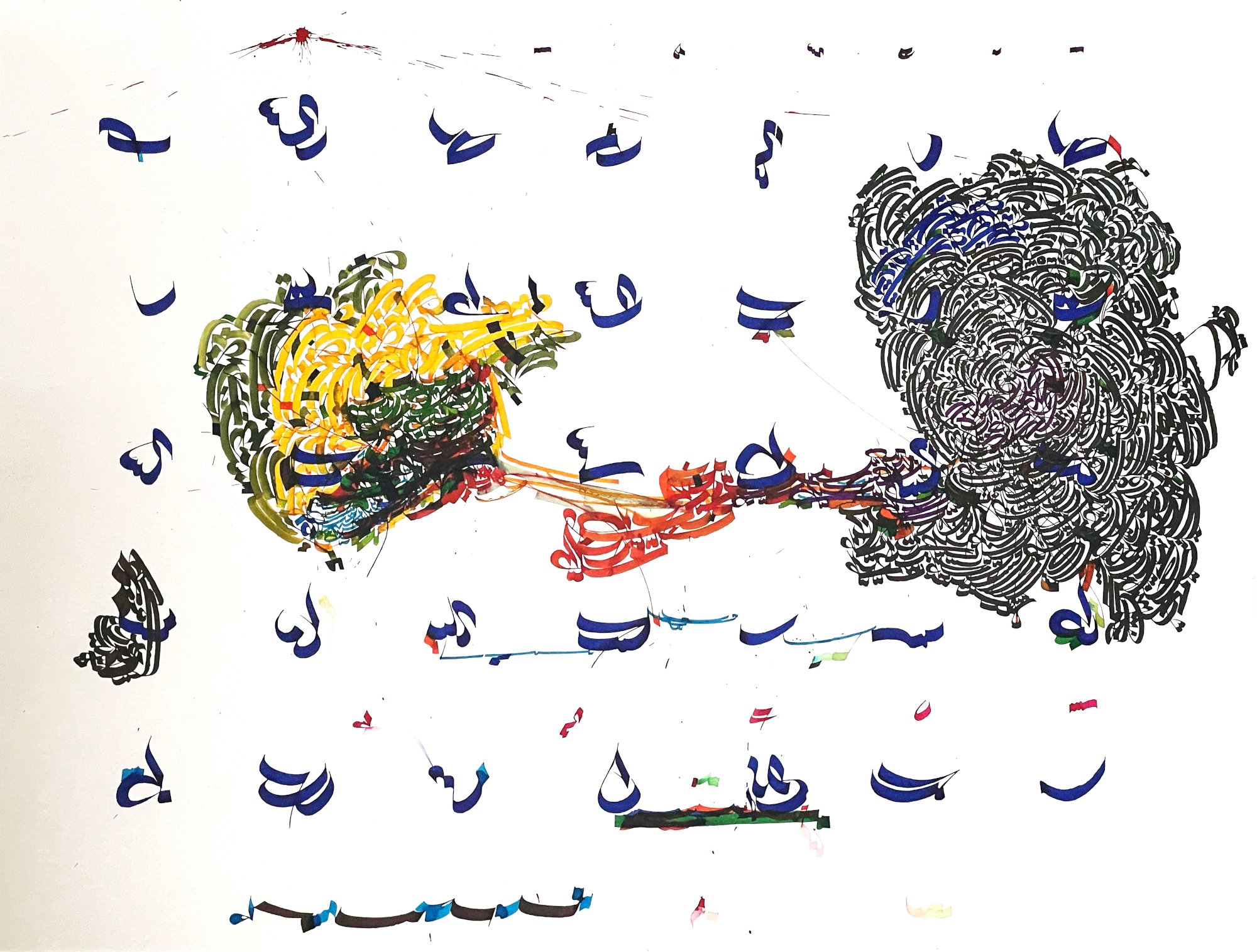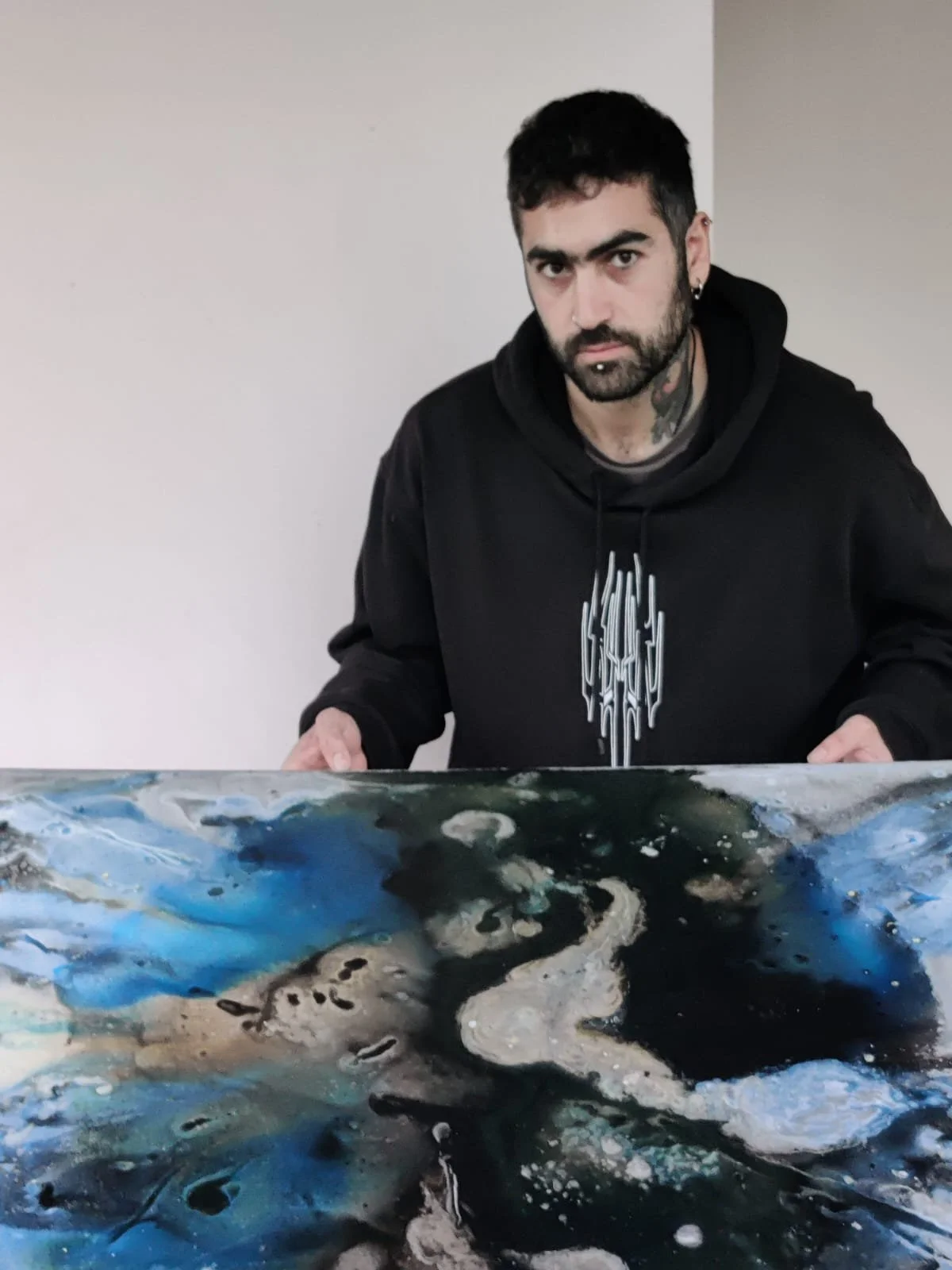10 Questions with Abdulrahman Naanseh
Syrian artist Abdulrahman Naanseh (b. 1991) learned Arabic calligraphy with the support of his father, a self-taught calligrapher. Naanseh has excelled in this field with three solo exhibitions during his residency at George Mason University, exhibitions with Arneli Art Gallery in Beirut, murals at Damascus University, solo exhibitions in Syria in 2002 and 2005, and national Arabic calligraphy competitions.
Naanseh is an Artist Protection Fund alumni and the 2022 Artist-in-Residence at George Mason University’s School of Art. The Artist Protection Fund (APF) fills a critical unmet need by awarding threatened artists and placing them at welcoming host institutions in safe countries where they can continue their work and plan for their futures.
Abdulrahman Naanseh - Portrait
ARTIST STATEMENT
“I graduated from the Fine Arts University in Damascus, with a degree in architectural design, but I couldn’t detach myself from the Arabic letter. Then I was forced to move to Beirut, and I’ve been working with the letters for twenty years, so I actually consider it the journey of my life. It’s also my style in dealing with everything, and my free space.
The traditional schools are essential, but it’s a creative state. We cannot stop at this state and say it’s done, and we cannot consider it only a decorative art. No, it’s a very abstract emotional art. We have the right to build upon it according to our current era, language of communication, and ideas. Anything we make has a relation with humans, so the people and the places are the circumstances that are very, very crucial to generate the artistic experiment of any artist.
I look forward to transporting my experience as a Syrian artist to the world, from a culture to a culture and from a language to a language through aesthetically enchanting compositions. I also aim to push the letter beyond being simply beautiful but rather have a cultural, artistic, moral, and human meaning.” - Abdulrahman Naanseh
INTERVIEW
Can you share with us a bit about your journey as an artist specializing in Arabic calligraphy? What initially drew you to this art form?
My journey began with a deep-rooted love for the aesthetic beauty and expressive power of Arabic calligraphy, inspired by my father’s passion for art. Over the years, I’ve honed my skills and developed a personal style that reflects both my heritage and my individual artistic vision.
The intricate beauty and historical depth of Arabic calligraphy captivated me from a young age. It’s an art form that carries the weight of centuries of cultural significance, and I was drawn to its potential for creative expression.
What challenges have you encountered as an artist from Syria, and how have these challenges influenced your artistic practice?
As an artist from Syria, I have faced many challenges, such as political and social turmoil, the lack of resources and opportunities, and the risk of censorship and persecution. These challenges have influenced my artistic practice in several ways. They have made me more aware of the importance of preserving and promoting the heritage and identity of my people. They have also inspired me to use my art as a way of expressing my thoughts and feelings, as well as raising awareness and solidarity for the issues that affect my country and region.
Postponent 3, Ink on Paper, 45.7x61 cm, 2024 © Abdulrahman Naanseh
How do you perceive the intersection between tradition and innovation in your work with Arabic calligraphy?
I view my work as a conversation between the past and the present. While I respect and draw from traditional calligraphic forms, I also strive to infuse my work with contemporary relevance and personal expression.
Could you discuss some of the major influences on your artistic style and approach to Arabic calligraphy?
My artistic style is influenced by the rich linguistic heritage of the Arabic language, the emotional depth of poetry and music, and the complex narratives of my homeland. These elements converge to shape a unique approach to calligraphy that is both reflective and forward-looking.
Can you walk us through your creative process? How do you go from the first idea to the final outcome?
My creative process begins with a concept, often a word or phrase that resonates with me. I explore its visual and linguistic possibilities through sketches and iterations, allowing the piece to evolve organically until it reaches its final form.
Expulsion 1, Ink on Paper, 45.7x61 cm, 2024 © Abdulrahman Naanseh
Expulsion 2, Ink on Paper, 45.7x61 cm, 2024 © Abdulrahman Naanseh
Are there specific messages or themes that you aim to convey through your art? If so, could you elaborate on them?
Absolutely. My art is deeply intertwined with the social and political struggles of Syria. Through the medium of Arabic calligraphy, I strive to capture the essence of our collective experience—highlighting the pressures we face, the movements we inspire, and the effects we endure. Each stroke and each line is a testament to the resilience and fortitude of the Syrian people, as we navigate the complexities of conflict and aspire for a harmonious future. My work is not just an artistic expression; it’s a narrative of our journey, our pain, and our unwavering hope.
How do you perceive the reception and understanding of Arabic calligraphy within the art community?
Arabic calligraphy is increasingly recognized for its artistic and cultural value. I hope my work contributes to a deeper appreciation of its nuances and potential as a medium for storytelling and emotional expression.
Is there anything else you would like to experiment with? Any new medium, theme, or technique you would like to incorporate into your work?
I’m always open to experimentation. I’m particularly interested in exploring how digital media and interactive installations can bring new dimensions to the experience of Arabic calligraphy.
Escapee, Ink on Paper, 45.7x61 cm, 2024 © Abdulrahman Naanseh
What are you working on now? Do you have any new projects or exhibitions coming up?
I’m currently exhibiting at Artomatic DC, which is a fantastic platform for artists of all kinds. Additionally, I’m excited to announce a new collective exhibition titled “Struggling to Be Heard,” which will run from July 5th to July 28th, 2024, at the Popcorn Gallery in Glen Echo Park, Maryland, USA. This exhibition will feature a series of my latest works that delve into the themes of communication and expression through the lens of Arabic calligraphy. It’s an exploration of how voices can be amplified or silenced in our society, and I’m looking forward to sharing it with everyone.
And lastly, where do you see yourself and your work five years from now?
In five years, I envision my work reaching a broader audience, sparking conversations and connections across cultures. I see myself continuing to push the boundaries of Arabic calligraphy, both honoring its traditions and charting new creative territories.
Artist’s Talk
Al-Tiba9 Interviews is a promotional platform for artists to articulate their vision and engage them with our diverse readership through a published art dialogue. The artists are interviewed by Mohamed Benhadj, the founder & curator of Al-Tiba9, to highlight their artistic careers and introduce them to the international contemporary art scene across our vast network of museums, galleries, art professionals, art dealers, collectors, and art lovers across the globe.



















